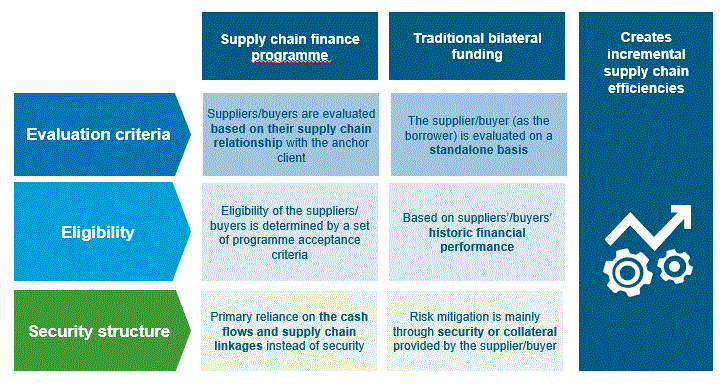A fresh approach to supply chain finance
Standard Chartered’s unique supply chain finance solution offers a win-win for both buyers and suppliers. By Michael Sugirin, Head of Open Account and Trade Implementation, Transaction Banking, Standard Chartered.

By design, globalisation has connected businesses around the world to a previously-unimaginable extent, and as a result global supply chains are more complex and convoluted than ever. Today, any product can traverse the world, stopping in numerous countries on the way before it eventually reaches its end customer. But for all the innumerable benefits this new commercial ecosystem has fostered, its complex web of connections can leave it open to risk in the event of such systems unravelling.
The Global Financial Crisis of 2008 was just such an occasion. An unforeseen contraction of demand across multiple industries challenged modern supply chains like never before. As the financial system crumbled in the wake of the Lehman Brothers collapse, the global economy was sent spiralling downwards.
The manufacturing sector suffered particularly severe consequences, with industries such as machinery, metals, and transportation equipment observing drops in customer orders of close to 50% in a single year. Many companies struggled to keep their heads above water and saw their entire supply chains decimated as a lack of cashflow bankrupted their smaller suppliers. The impact was still felt at magnitude years later; according to the International Labour Organisation in 2013, five years on from the crisis, there were still 39 million less jobs in the global supply chain than in 2007.
Companies are increasingly becoming aware that supplier relationship management is key to ensuring a strong supply base, and are putting more emphasis on supply chain sustainability and good sourcing practices. This means having stronger collaboration with key suppliers; yielding greater value than having distant relationships with thousands of suppliers.
At Standard Chartered, we have also been working to mitigate the innate vulnerability of supply chains. We believe the solution is to bank not just the client but their entire ecosystem as well – from the smallest of suppliers to the largest of multinationals.
The limitations of payables finance
More and more companies are solutions to support their suppliers. According to a 2015 McKinsey report, global supply chain finance revenue grew 20% per year from 2010-2015, with projected growth of 15% per year expected for the three to five years thereafter.
Moreover, the supply chain finance market has outpaced the traditional trade finance market– as of 2016, supply chain finance composed 54% of the total trade finance revenue pool and is expected to increase to up to 57% by 2020. With over $2 trillion in financeable payables globally as of 2016, supply chain finance represents potential revenue of over $20 billion. One of the most common solutions is payables finance. Most banks provide payables finance programmes that help suppliers access liquidity on the back of the buyer’s accepted invoices by means of a receivables purchase. These programmes incur less risk as finance is given after the buyer has accepted the invoices. The buyers for these programmes are typically large corporations with credit standings typically higher than those of their suppliers.
In payables finance programme, suppliers are given an option to receive the discounted value of their receivables before the invoice due date. They typically get access to this liquidity at a more attractive rate than they would otherwise get on their own – due to the higher credit standing of the buyer.
We’ve noticed that while payables finance helps suppliers’ access liquidity, it usually comes too late as some suppliers, particularly smaller ones, encounter shortfalls prior to production. Some may not have enough liquidity to procure the raw materials needed to fulfil the purchase order (PO) and must therefore turn to traditional financing from their banks. As suppliers are typically smaller companies whose credit standings may fall short of banks’ funding criteria, the liquidity they access may come at a high price, may require considerable collateral, or may not be available to them at all. Consider a big fashion retailer (the buyer) procuring from a garment manufacturer in Asia. The buyer orders USD1 million of shirts from the manufacturer. In order to produce the shirts, the manufacturer needs funds to buy raw materials. Being short on liquidity, the manufacturer might turn to its bank for a loan.
Assuming the retailer has a payables finance programme in place with the supplier (manufacturer), the supplier only has access to liquidity after the invoices have been approved. This only comes after the goods have been shipped, which may be too late for the supplier to meet the full order.
Going beyond – or before – payables finance
We have recognised this gap and have developed a supplier finance offering that helps both the buyer and the supplier. It enables buyers to support their key suppliers, while offering their suppliers access to liquidity at a much earlier stage.
By expanding payables finance to include purchase order (PO) financing earlier in the procurement process, we can give suppliers access to funding at more favourable rates than traditional financing because of the comfort we derive from the strong relationship between them and the buyer. Through PO financing, suppliers are given the option to obtain finance once the buyer submits a purchase order, offering them the liquidity to procure the raw materials they need to fulfil the buyer’s PO.
Once the suppliers have shipped the goods and the buyer has accepted the related invoices, our system can check if there are any outstanding PO financing obligations before disbursing the discounted payables financing proceeds to the suppliers.
For our garment manufacturer, this means it would immediately have access to fiannce once the retailer submits the PO to Standard Chartered. Similarly, once the goods have been shipped and the buyer has accepted the invoice, the PO financing obligation is automatically converted to a payables finance obligation. The discounted invoice proceeds will be used to liquidate the PO financing obligation before the supplier’s account is credited with the residual amount excluding charges (See Table 1).
Our approach to financing the supply chain
We acknowledge that all stakeholders have different supply chain needs, which is why we believe in giving flexibility to both buyers and suppliers. Accordingly, we are developing industry-focused solutions to structure programmes.
For buyer clients, on top of the flexibility to choose options for PO-invoice matching and systems integration, we offer customisable solutions that enable them to mix and match various supply chain finance offerings, to structure a programme that best fits their requirements. Goods move through different stages in a typical supply chain – form raw materials all the way to end-user consumption. We believe that each stage of this journey has different financing requirements – and we aim to provide seamless solutions for each stage to our clients.
We offer suppliers the flexibility to choose between automatic or selective PO and payables, which means they can opt to either automatically or selectively receive proceeds whenever a PO or accepted invoice is submitted (see Diagram 1).
Through our geographical footprint and business model, we are able to support our clients and their global networks of suppliers. Our business model, together with our footprint markets, enable us to support businesses of different sizes in numerous markets in which other banks are limited. Our commercial banking and business banking offerings enable us to on-board smaller suppliers across procurement markets in Asia, Africa and the Middle East.
We continuously strive to develop supply chain finance solutions that will help address our clients’ evolving needs. We believe in fostering our clients and their ecosystems; providing them with access to banking solutions across their supply chains to enable their sustainable growth. So as our clients’ supply chains globalise, so do we.
Sponsored editorial







